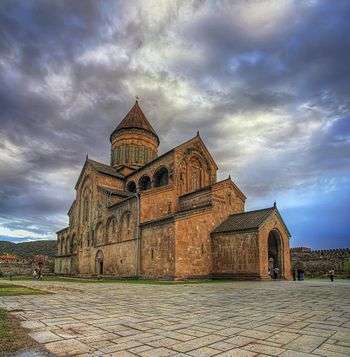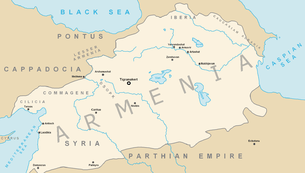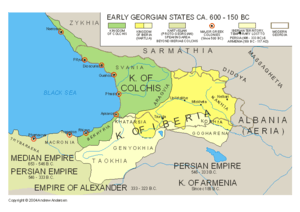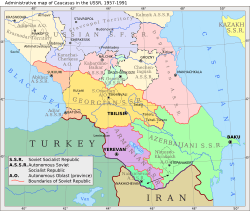History of the Caucasus


One can divide the history of the Caucasus region into the history of the Northern Caucasus (Ciscaucasia), historically in the sphere of influence of Scythia and of Southern Russia (Eastern Europe), and that of the Southern Caucasus (Transcaucasia; Caucasian Albania, Georgia, Armenia), in the sphere of influence of Persia, Anatolia and for a very brief time Assyria.
Up to including the early 19th century, the Southern Caucasus and a part of the Northern Caucasus (Dagestan) all formed part of the Persian Empire. In 1813 and 1828 by the Treaty of Gulistan and the Treaty of Turkmenchay respectively, the Persians were forced to irrevocably cede the Southern Caucasus and Dagestan to Imperial Russia.[1] Russia conquered and annexed the rest of the Northern Caucasus in the course of the 19th century in the Caucasian Wars (1817–1864).
The Northern Caucasus became the scene of intense fighting during the Second World War. Nazi Germany attempted to capture the Caucasus region from Soviet control in 1942 by a two-pronged attack towards both the western bank of the Volga (intending to seize the city of Stalingrad) and by a drive southeast towards Baku, a major center of oil production. The Nazis intended to establish a Reichskommissariat Kaukasus to control the Caucasian territories of the Soviet Union. Considerable parts of the northern Caucasus fell under German occupation, but the invasion eventually faltered as it failed to accomplish either goal, and Soviet soldiers drove the Germans back west following the Battle of Stalingrad (1942–1943).
Following the dissolution of the Soviet Union in 1991, Armenia, Azerbaijan, and Georgia became independent nations. The Caucasus region has become the setting for various territorial disputes since the collapse of the Soviet Union, leading to the Nagorno-Karabakh War, the Ossetian-Ingush conflict, the War in Abkhazia, the First and Second Chechen Wars, and the South Ossetia War.
Prehistory
Stone Age
Bronze Age
- Maykop culture
- Leyla-Tepe culture
- Kura-Araxes culture
- Trialeti culture
- Jar-Burial Culture
- Kurgan culture
- Nakh peoples
- Khojaly-Gadabay culture (c. 1300 – 600 BC)
- Kingdom of Arme-Shupria (c. 1300-1190 BC)
- Colchian culture (c. 1200 – 600 BC)
Iron Age
- Kingdom of Diauehi (12th - 9th century BC)
- Nairi (1114–860 BC)
- Koban culture (c. 1100 – 400 BC)
- Kingdom of Urartu (c. 860 – 590 BC)
- Nakh peoples
- Assyrian Empire (c. 934 BC – 609 BC)
Classical Antiquity
- Kingdom of Colchis
- Persia
- Media (728 BC – 549 BC)
- Achaemenid Empire (c. 550 BC – 330 BC)
- Parthia (247 BC – AD 224)
- Sassanid Empire (224–651)
- Kingdom of Armenia
- Kingdom of Caucasian Albania
- Kingdom of Caucasian Iberia
- Kingdom of Lazica-Egrisi.
- Roman Empire (114-117 AD)
 Ancient countries of the Caucasus - Armenia, Colchis, Iberia and Albania
Ancient countries of the Caucasus - Armenia, Colchis, Iberia and Albania Greatest extent of Kingdom of Armenia under Tigranes the Great
Greatest extent of Kingdom of Armenia under Tigranes the Great
Middle Ages

- Sassanian Empire (224-651)
- Byzantine Empire (330–1453)
- Khazars
- Arab Caliphate
- Rashidun Caliphate (632–661)
- Umayyad Caliphate (661–750)
- Abbasid Caliphate (750–1258)
- Kingdom of Georgia (1008-1490)
- Kingdom of Abkhazia (767-1014)
- Kingdom of Tao-Klarjeti (888–1008)
- Kingdom of Kakheti-Hereti (1020s–1104)
- Kingdom of Imereti (1260–1810)
- Samtskhe-Saatabago (1266–1625)
- Kingdom of Kakheti (1465–1762)
- Kingdom of Kartli (1466–1762)
- Persia
- Shirvanshah
- Kingdom of Armenia (Middle Ages)
- Seljuq dynasty (1037–1194)
- Ilkhanate (1256–1335)
- Timurid dynasty (1370–1526)
Early modern history

By the end of the 15th century, the Kingdom of Georgia was fragmented into a number of petty client kingdoms subject to either Persia (Kingdom of Kakheti, Kingdom of Kartli) or the Ottomans (Kingdom of Imereti).)[note 1]
The nascent Russian Empire gains territories in the North Caucasus in the Russo-Persian war of 1722/3. Following the death of Nader Shah, Kartli and Kakheti were merged into the Kingdom of Kartli-Kakheti in 1762, seceding from Persian overlordship. King Erekle II concluded the Treaty of Georgievsk with the Russian Empire. Catherine the Great used Georgia as a base of operations against both Iran and the Ottoman Empire. The Qajar dynasty attempted to restore Persian hegemony over the Caucasus. A Persian invasion force defeated the Georgian army in the Battle of Krtsanisi in 1795, but soon lost its grip over the Caucasus once again, after the assassination of Agha Mohammad Khan in 1797, leading to the Russian annexation of Georgia in 1801.
While Georgia and Armenia remained Christian, the Chechens gradually adopted Sunni Islam.[2] The Circassians were mostly Islamized under the influence of the Crimean Tatars and the Ottoman Empire in the 17th century.
Modern history
Russian Empire and Civil War
- Georgia within the Russian Empire (1801–1918)
- Russian Civil War
- Volunteer Army (1918–1920)
- Kuban People's Republic (1918–1920)
- Mountainous Republic of the Northern Caucasus (1918–1920)
- Democratic Republic of Georgia (1918-1921)
- Transcaucasian Democratic Federative Republic
 Karte des Kaukasischen Isthmus. Entworfen und gezeichnet von J. Grassl, 1856.
Karte des Kaukasischen Isthmus. Entworfen und gezeichnet von J. Grassl, 1856. Poster from Russian civil war period
Poster from Russian civil war period- File::Karachov Kazak rug, mid-19th C.jpgKarachov Kazak rug, mid-19th century
Soviet Union
- Soviet Union
- Nagorno-Karabakh War (1988–1994)
- Ossetian-Ingush conflict (1989–1991)
- Chechen Republic of Ichkeria (1991–2000)
- Republic of Georgia (since 1991)
- Republic of Armenia (since 1991)
Recent history (1991–present)
- War in Abkhazia (1992–1993)
- First Chechen War, 1994–1996
- Second Chechen War, 1999–2006
- Russo-Georgian War, 2008
See also
- Caucasus Greeks
- North Caucasus
- South Caucasus
- History of Georgia (country)
- History of Armenia
- History of Azerbaijan
- History of Abkhazia
- History of Chechnya
- History of Nagorno-Karabakh
- History of Nakhchivan
- Southern Russia
- Eastern Magyars
- North Caucasian Huns
- Huns
- Khazars
- Western Turkic Khaganate
Further reading
- Asmus, Ronald. A Little War that Shook the World : Georgia, Russia, and the Future of the West. NYU (2010). ISBN 978-0-230-61773-5
- de Waal, Thomas. Black Garden. NYU (2003). ISBN 0-8147-1945-7
- Gasimov, Zaur: "The Caucasus", European History Online, Mainz: Institute of European History, 2011, retrieved: November 18, 2011.
- Goltz, Thomas. Azerbaijan Diary : A Rogue Reporter's Adventures in an Oil-Rich, War-Torn, Post-Soviet Republic. M E Sharpe (1998). ISBN 0-7656-0244-X
- Goltz, Thomas. Chechnya Diary : A War Correspondent's Story of Surviving the War in Chechnya. M E Sharpe (2003). ISBN 0-312-268-74-2
- Goltz, Thomas. Georgia Diary : A Chronicle of War and Political Chaos in the Post-Soviet Caucasus. Thomas Dunne Books (2003). ISBN 0-7656-1710-2
- Shapi, Kaziev. Caucasian highlanders (Повседневная жизнь горцев Cеверного Кавказа в XIX в.). Everyday life of the Caucasian highlanders. 19th century (In the co-authorship with I.Karpeev). "Molodaya Gvardiy" publishers. Moscow, 2003. ISBN 5-235-02585-7
Notes
- ↑ From 1258, Imereti was considered a separate kingdom within the Kingdom of Georgia (1008–1490). However, the start of the rule of the Second House of Imereti in 1455 is from where it became independent from the Kingdom of Georgia and would form its definite own entity.
- ↑ Timothy C. Dowling Russia at War: From the Mongol Conquest to Afghanistan, Chechnya, and Beyond pp 728-730 ABC-CLIO, 2 dec. 2014. ISBN 978-1598849486
- ↑ Tsaroïeva, Mariel (2005). Anciennes croyances des Ingouches et des Tchétchènes: peuples du Caucase du Nord (in French). Paris: Maisonneuve et Larose. ISBN 2-7068-1792-5.


